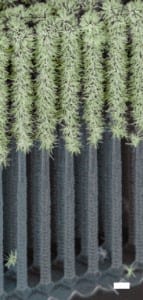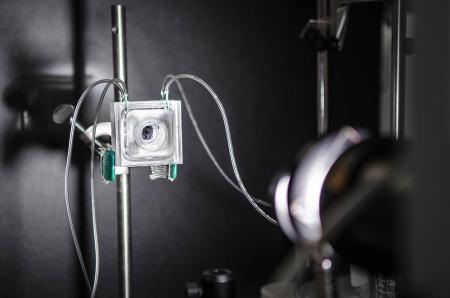
Berkeley Lab Researchers Report First Fully Integrated Artificial Photosynthesis Nanosystem
In the wake of the sobering news that atmospheric carbon dioxide is now at its highest level in at least three million years, an important advance in the race to develop carbon-neutral renewable energy sources has been achieved. Scientists with the U.S. Department of Energy (DOE)’s Lawrence Berkeley National Laboratory (Berkeley Lab) have reported the first fully integrated nanosystem for artificial photosynthesis. While “artificial leaf” is the popular term for such a system, the key to this success was an “artificial forest.”
“Similar to the chloroplasts in green plants that carry out photosynthesis, our artificial photosynthetic system is composed of two semiconductor light absorbers, an interfacial layer for charge transport, and spatially separated co-catalysts,” says Peidong Yang, a chemist with Berkeley Lab’s Materials Sciences Division, who led this research. “To facilitate solar water- splitting in our system, we synthesized tree-like nanowire heterostructures, consisting of silicon trunks and titanium oxide branches. Visually, arrays of these nanostructures very much resemble an artificial forest.”
Yang, who also holds appointments with the University of California Berkeley’s Chemistry Department and Department of Materials Science and Engineering, is the corresponding author of a paper describing this research in the journal NANO Letters. The paper is titled “A Fully Integrated Nanosystem of Semiconductor Nanowires for Direct Solar Water Splitting.” Co-authors are Chong Liu, Jinyao Tang, Hao Ming Chen and Bin Liu.
Solar technologies are the ideal solutions for carbon-neutral renewable energy – there’s enough energy in one hour’s worth of global sunlight to meet all human needs for a year. Artificial photosynthesis, in which solar energy is directly converted into chemical fuels, is regarded as one of the most promising of solar technologies. A major challenge for artificial photosynthesis is to produce hydrogen cheaply enough to compete with fossil fuels. Meeting this challenge requires an integrated system that can efficiently absorb sunlight and produce charge-carriers to drive separate water reduction and oxidation half-reactions.
“In natural photosynthesis the energy of absorbed sunlight produces energized charge-carriers that execute chemical reactions in separate regions of the chloroplast,” Yang says. “We’ve integrated our nanowire nanoscale heterostructure into a functional system that mimics the integration in chloroplasts and provides a conceptual blueprint for better solar-to-fuel conversion efficiencies in the future.”
The Latest Bing News on:
Artificial photosynthesis
- JinkoSolar gets grant for improved solar cell structure for enhanced photoelectric conversionon May 6, 2024 at 3:19 am
Revolutionize solar cell efficiency with JinkoSolar's patented design featuring pyramid structures and precise doping concentrations. Learn more about this innovative technology now!
- JinkoSolar gets grant for photovoltaic cell with metal and non-metal pattern regionson May 6, 2024 at 2:30 am
Discover the groundbreaking patent by JinkoSolar for a novel photovoltaic cell design with pyramid structures, tunneling layers, and doped conductive layers to enhance solar energy conversion ...
- Toward artificial leaves that float on water, bubbling fuelon May 2, 2024 at 2:14 pm
Researchers have now made such an artificial leaf device using an organic photovoltaic (OPV) material. Depending on the catalyst used, the device either splits water to make hydrogen fuel or splits ...
- The 8 Best Grow Lights for Countertop Herbs, Small Gardens, and Helping Indoor Plants Thriveon April 30, 2024 at 2:33 pm
Narrow spectrum lights are noted for serious gardeners and plant nerds who need to support different stages of development. Blue-light spectrum (450-490 nm) grow lights are used for early-stage growth ...
- The Advantages of Going Solaron April 29, 2024 at 9:33 am
This article explores the numerous advantages of adopting solar energy, both from an environmental standpoint and its capacity to influence economic and personal development.
- Is Artificial Photosynthesis the Next Source of Renewable Energy?on February 19, 2024 at 9:09 pm
Photosynthesis is the process by which plants convert sunlight into energy, inspiring sustainable energy solutions. Artificial photosynthesis aims to imitate the process of photosynthesis to ...
- The other half of the equationon October 20, 2023 at 12:43 am
Artificial photosynthesis — splitting water with light — is an attractive way to make hydrogen, but what happens to the oxygen? A catalyst that aids in the efficient production of gaseous ...
- Artificial Photosynthesis: A Game Changer for Clean Energyon September 25, 2023 at 5:00 pm
that brings us a step closer to the day carbon dioxide could be used as a resource.
- Artificial photosynthesis machines invented to create oxygen in space for astronautson June 13, 2023 at 11:15 am
In a game-changing technological breakthrough, scientists are creating artificial photosynthesis devices that astronauts will use on future space missions. On our lush and abundant planet Earth ...
- Artificial Photosynthesis—Making Fuels Directly from Sunlighton May 13, 2022 at 5:40 pm
Nathan Lewis will present about the discovery and development of materials and a system architecture for the direct production of fuels from sunlight. The membrane-embedded microwire array approach is ...
The Latest Google Headlines on:
Artificial photosynthesis
[google_news title=”” keyword=”artificial photosynthesis” num_posts=”10″ blurb_length=”0″ show_thumb=”left”]
The Latest Bing News on:
Artificial forest
- United States Forest Serviceon May 7, 2024 at 1:44 am
"Sunday Morning" has an exclusive behind-the-scenes look at the creation of the country singer's first post-stroke song, "Where That Came From," which blends art with artificial intelligence in a ...
- Artificial intelligence enhances monitoring of threatened marbled murreleton May 2, 2024 at 11:22 am
Artificial intelligence analysis of data gathered by acoustic recording devices is a promising new tool for monitoring the marbled murrelet and other secretive, hard-to-study species, research by ...
- Artificial intelligence enhances monitoring of threatened marbled murreleton April 30, 2024 at 5:00 pm
Artificial intelligence analysis of data gathered ... research by Oregon State University and the U.S. Forest Service has shown. The threatened marbled murrelet is an iconic Pacific Northwest ...
- How AI could become an unlikely ally in the fight against forest fireson April 30, 2024 at 6:30 am
A swarm of drones dart across black clouds of smoke, analysing the direction and intensity of the inferno below. The data is fed back to a ‘super-computer’ located many miles away and informs ...
- Maps developed with artificial intelligence confirm low levels of phosphorus in Amazonian soilon April 29, 2024 at 2:32 pm
As the impacts of climate change increasingly affect the daily lives of residents in several countries, including Brazil, the resilience of forests, especially tropical ones such as the Amazon, has ...
- Maps developed with artificial intelligence confirm low levels of phosphorus in Amazonian soilon April 29, 2024 at 11:07 am
The forest regression models showed average accuracy ... “Machine learning, with the use of artificial intelligence, will be increasingly applied in science, especially for future projections.
- AI cameras to be installed at 90 conflict points across T.N.’s Gudalur forest division to curb human-elephant conflicton April 29, 2024 at 4:29 am
Gudalur Forest Division to install AI cameras at conflict points to reduce human-elephant interactions, protecting wildlife and communities.
- National school safety group launching volunteer patrols in Carolina Forest area following string of bomb threatson April 28, 2024 at 7:52 am
Two students were charged on Friday after a bomb threat at Carolina Forest High School the night before ... However, it appears to have been generated by artificial intelligence programs and shared ...
- New Facebook AI chatbot spreads misinformation about threat at Carolina Forest HSon April 25, 2024 at 4:43 pm
Members of the community were concerned after heading to Facebook to learn more about Thursday's bomb threat at Carolina Forest High School on Thursday.County spokesperson Mikayla Moskov said ...
- Authorities trace threats at Carolina Forest High School to internet server in Indiaon April 25, 2024 at 1:17 pm
Horry County authorities investigating bomb threats and a “swatting incident” on back-to-back days at Carolina Forest High School said Thursday ...
The Latest Google Headlines on:
Artificial forest
[google_news title=”” keyword=”artificial forest” num_posts=”10″ blurb_length=”0″ show_thumb=”left”]











